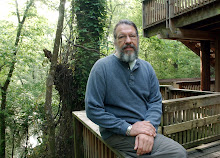Sunrise on Hackberry Row
Upper Lafayette Parish, Louisiana
13 January 2012
What a symphony out back this morning! It was still below-freezing when I brought my coffee out onto the back porch. The sun had just risen, and new rays were bouncing like mad off of the ashy-gray trunks of the hackberry trees. Dozens upon dozens of robins and cedar waxwings were feasting up at the tops of the hackberries, with dozens and dozens of hackberry seeds pinging off of the tin roofs of Lydia's old mammal enclosures (she functioned as a wild mammal rehabber for many years). The steady seed-pinging laid down the rhythm, upon which many robins overlaid with their joyful spring courtship songs. The cedar waxwings and house finches provided background vocals.
ping! ping! ptweet! ptweet! ping! ping! ptweet! etc.
I mean, what could I do? I had to report this to you, gentle readers.
Called “sugarberry” by foresters and some botanists, the hackberry is an amazingly adaptive tree, possessing a U.S. range spanning the entire continent from Atlantic to Pacific to Gulf Coasts (see http://plants.usda.gov/java/profile?symbol=CELA). Right here in the south-central U.S. hackberry occupies habitats disparate as the mucky bottomland hardwood forests of Louisiana's Atchafalaya Basin to the water-starved clay hills around Dallas.
Earlier this winter – back in early November, when leaves were still on most of the trees – I predicted that due to the drought of 2011, this winter's hackberry crop would probably hover somewhere between sub-par and awful. Turned out I was wrong. Thankfully so. Beginning sometime around the first week of December, robins began descending into the large hackberry grove that borders the northern and eastern edges of our homesite. This went on for weeks. By Christmas, flocks of cedar waxwings and eastern bluebirds had joined the massive robin flocks. Today (13 January) they're still working it like mad. Upon closer inspection of the now leafless trees, I noticed (through binoculars) that the hackberry crop is, if anything, heavier than normal, but that the berries are noticeably smaller. Smaller but, to the great delight of the robins, sweeter. Alrighty then!
American Robin: munchin' & ptweetin'
Within the ecosystems in which they occur, hackberries are major players in providing winter calories for wild birds and mammals. Here in Louisiana, for example, we conducted a 5-year statewide bird frugivory survey in the latter half of the 1990s. Regarding diversity of bird species utilizing the fruits, hackberry ranked numero uno of the 50 species of berry-producing plants observed, serving 27 different bird species.
Hackberry (Celtis laevigata, aka "sugarberry")
As previously mentioned, the hackberry has been nicknamed “sugarberry” due to the sweetness of its berries. Actually, the berries hold very little pulp. Each berry is enclosed in a rather thick, sweet-tasting husk, underlain by a thin, orange-colored, insipidly-sweet, slimy layer of pulp surrounding a large seed. Given the miniscule amount of pulp involved in each berry, it follows that birds need to eat lots of hackberries in order to obtain nutritional benefit – mammals, even more. And eat them they do, in vast quantities. Lydia and I have seen both raccoons and fox squirrels as well as birds such as yellow-breasted chats eating unripened hackberries as early as August.
sugarberries: shucked, unshucked, half-shucked
In Edible Plants of the Gulf (see http://www.nativeventures.net/books.php) Louisiana botanist Charles Allen wrote that native Americans used hackberries for sustenance as well, grounding the entire berries to use as a flavoring. In Trees, Shrubs, and Woody Vines of Louisiana Allen reports that Indians used the bark of hackberry to treat sore throat and venereal diseases.
Hackberry is an elm family (Ulmaceae) member; and like its close cousins, the elms, its wood is not much good for anything – not even for firewood. Yep. Somewhat useless to contemporary white folks; priceless to wildlife. . . that's sort of the way it goes.







No comments:
Post a Comment